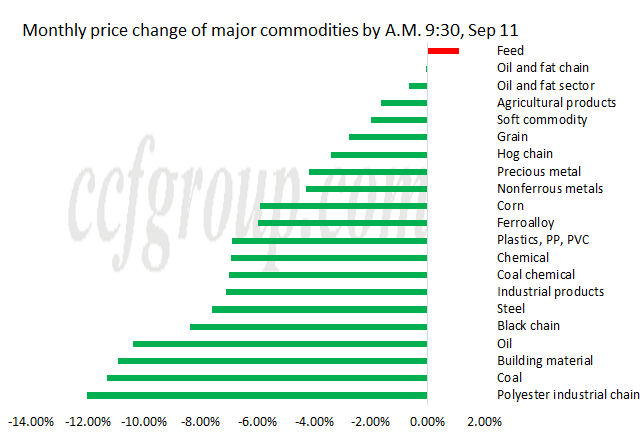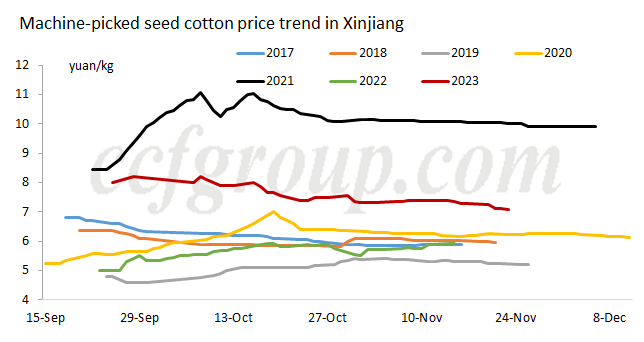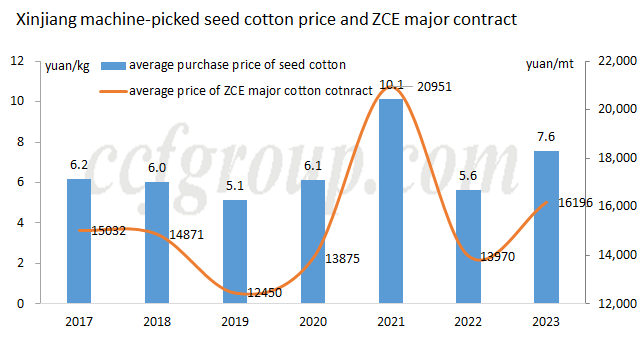Attention on the seed cotton price with the approaching arrivals of new cotton
Influenced by the sharp decline in crude oil prices, the prices across the polyester industrial chain are experiencing a rapid downturn, with products involving futures trading hitting new lows in particular. The accumulated decline for the polyester chain this month has already reached around 12%, placing it at the top of the commodity price decline list. Following behind are the coal, building materials, and oil sectors.

In contrast, agricultural products saw relatively minor declines in Sep, with a cumulative decrease of less than 2%, suggesting a somewhat favorable performance. However, under the backdrop of significant macroeconomic pressures and insufficient demand, market confidence is generally weak. Cotton, as an important agricultural product, is approaching the period of new crop arrivals, and the market is particularly focused on the situation of seed cotton procurement. The general expectation is that the price for machine-picked seed cotton will be around 5.5-6yuan/kg, with a cautious attitude guiding the procurement. Therefore, from the perspective of preparation and mindset, the price of seed cotton this year may be anchored to the futures market. Of course, due to discrepancies between cotton farmers and ginning factories regarding the price, there may be a period of bargaining in the early stages of availability.

In the past, machine-picked seed cotton in Xinjiang has typically entered the market in late Sep, with procurement lasting approximately 40 days. The period was longer in 2020-2021, at just over two months. Looking at the procurement price, the average price from 2017 to 2023 has been around 6.7yuan/kg, with an average value of around 6.1yuan/kg after excluding the unusually high price in 2021. In recent years, the correlation between seed cotton price and the Zhengzhou cotton futures market has gradually increased, with a correlation coefficient of up to 0.98 during the arrival period from 2017 to 2023, indicating a close relationship between the two, despite some variation in correlation coefficients across different years.
| Correlation of Xinjiang machine-picked seed cotton and ZCE major cotton contract during the arrival | |||||||
| 2017 | 2018 | 2019 | 2020 | 2021 | 2022 | 2023 | |
| correlation coefficient | 0.7025 | 0.3052 | 0.8541 | 0.8656 | 0.8674 | 0.1231 | 0.9803 |

Note: The calculation period for the futures average aligns with the seed cotton arrival time, which varies each year.
In 2019, the average price for machine-picked seed cotton was as low as around 5.1yuan/kg, with the average price of the ZCE major cotton contract below 12,500yuan/mt, fluctuating between 12,000-13,000yuan/mt. From 2017 to 2023, the spot price has consistently been higher than the major cotton contract price during the same period, with significant differences in the price difference between the futures and spot markets each year. In recent three years, the average price difference maintained around 900-1,000yuan/mt. The machine-picked seed cotton in Xinjiang has not yet begun to be harvested this year, and the initially expected arrival time is expected to be delayed due to weather conditions in Xinjiang, but the mainstream expectation for the price is within the range of 5.5-6yuan/kg.
In summary, the overall commodity market atmosphere has been relatively weak recently, with most commodities in a state of decline. After a significant fall in Aug, cotton price has seen a rebound, but its performance has also been weak, yet stronger than the polyester industrial chain. However, with the upcoming new cotton arrivals, the market is closely watching the seed cotton procurement price. Based on current market feedback, a rush for procurement is unlikely to occur, and the price in the early period is also expected to be difficult to exceed 6yuan/kg, with some predicting even lower prices. Under such expectations, both downstream enterprises and traders are generally cautious, focusing on digesting the inventory, and the speculative demand is hard to be stimulated.
- Top keywords
- Cotton Price
- Cotton Futures Price
- Cotton Futures
- CZCE
- PTA Futures Price
- Chemical Fiber
- Polyester Prices
- Wool price
- PTA Futures
- Shengze Silk
- China
- Yarn Price
- price
- China Textile City
- Fibre Price
- Benzene Price
- Cotton
- Index
- Cotton Index
- PTA
- fabric price
- NYMEX
- Top 10
- textile industry
- Spot Cotton
- Cotton Yarn
- Polyester Price
- Futures
- PTA Price
- cotton yarn price

